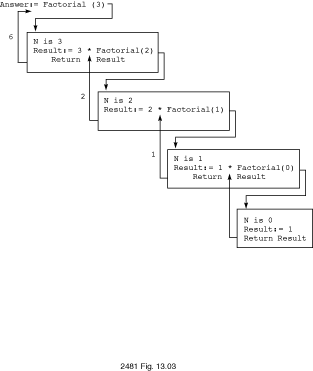
Many mathematical functions are defined recursively. An example is the factorial of a number n (n!).
Example 13.2
Function Factorial in
Program
13.3 computes the factorial of its argument N.
Program 13.3
Recursive Factorial Function
FUNCTION Factorial (N : IN Natural) RETURN Positive IS
-- Computes the factorial of N (N!) recursively
-- Pre : N is defined and N >= 0
-- Post: returns N!
BEGIN -- Factorial
IF N = 0 THEN
RETURN 1; -- stopping case
ELSE
RETURN N * Factorial(N-1); -- recursion
END IF;
END Factorial;
The recursive step
Result := N * Factorial(N-1);
implements
the second line of the factorial definition above. This means that the result
of the current call (argument N) is determined by multiplying the
result of the next call (argument N-1) by N.A trace of
Answer := Factorial(N => 3);
is
shown in
Figure
13.3.
Figure 13.3
Trace of Answer := Factorial(3)

The value returned from the original call, Factorial(N =>
3), is 6, and this value is assigned to
Answer. Be careful when using the factorial function; its value
increases very rapidly and could lead to an integer overflow exception (e.g.,
10! is 24,320).
Although the recursive implementation of function Factorial
follows naturally from its definition, this function can be implemented easily
using iteration. The iterative version is shown in
Program
13.4; it is in fact the same function that appeared back in
Program
5.19, as one of the useful functions there.
Program 13.4
Factorial, Iterative Version
FUNCTION Factorial_Iterative (N : IN Natural) RETURN Positive IS
-- Computes the factorial of N (N!) iteratively
-- Pre : N is defined and N >= 0
-- Post: returns N!
Result : Positive; -- holds the product
BEGIN -- Factorial_Iterative
Result := 1;
FOR Count IN 2 .. N LOOP
Result := Result * Count;
END LOOP;
RETURN Result;
END Factorial_Iterative;
Note
that the iterative version contains a loop as its major control structure,
whereas the recursive version contains an IF statement.
Example 13.3
The Fibonacci numbers are a sequence of numbers that have many varied uses. They were originally intended to model the growth of a rabbit colony. The Fibonacci sequence 1, 1, 2, 3, 5, 8, 13, 21, 34,... increases rapidly: Each number in the sequence is the sum of the two previous ones. The fifteenth number in the sequence is 610 (that's a lot of rabbits). The Fibonacci sequence is defined below.
Verify for yourself that the
sequence of numbers shown above is correct. A recursive function that computes
the Nth Fibonacci number is shown as
Program
13.5. Although easy to write, the Fibonacci function can run rather slowly
because each recursive step generates two recursive calls to function
Fibonacci.
Program 13.5
FUNCTION Fibonacci (N : IN Natural) RETURN Positive IS
-- Returns the Nth Fibonacci number, computed recursively
-- Pre : N is defined and N >= 0
-- Post: returns N!
BEGIN -- Fibonacci
IF (N = 1) OR (N = 2) THEN
RETURN 1;
ELSE
RETURN Fibonacci(N-2) + Fibonacci(N-1);
END IF;
END Fibonacci;
The greatest common divisor (GCD) of two positve integers is the largest integer that divides them both; Euclid's algorithm for finding the GCD is defined recursively as follows:
This algorithm states that the GCD is N if
N is the smaller number and N divides M. If M is
the smaller number, the GCD determination should be performed with the
arguments transposed. If N does not divide M, the answer is
obtained by finding the GCD of N and the remainder of M divided
by N. The Ada function GCD is shown as
Program
13.6.
Program 13.6
FUNCTION GCD (M, N : IN Positive) RETURN Positive IS
-- Pre : M and N are defined.
-- Post: Returns the greatest common divisor of M and N.
Result: Positive;
BEGIN -- GCD
IF (N <= M) AND (M REM N = 0) THEN
Result := N;
ELSIF M < N THEN
Result := GCD(N, M);
ELSE
Result := GCD(N, M REM N);
END IF;
RETURN Result;
END GCD;
**), we
could write our own. Complete the following recursive function that calculates
the value of a number (Base) raised to a power (Power).
FUNCTION PowerOf (Base: Integer; Power: Positive) RETURN Integer IS
Result: Integer;
BEGIN -- PowerOf
IF Power = ______ THEN
Result := ________ ;
ELSE
Result := ________ * ________ ;
END IF;
END PowerOf;
Strange compute?
WITH Ada.Text_IO;
WITH Ada.Integer_Text_IO;
PROCEDURE TestStrange IS
FUNCTION Strange (N : Integer) RETURN Integer IS
Result: Integer;
BEGIN
IF N = 1 THEN
Result := 0;
ELSE
Result := 1 + Strange (N / 2);
END IF;
END Strange;
BEGIN -- TestStrange
Ada.Integer_Text_IO.Put(Item => Strange(8);
Ada.Text_IO.New_Line;
END TestStrange;
FindSum, that calculates the sum
of successive integers starting at 1 and ending at N (i.e.,
FindSum(N) = (1 + 2 + ... + (N - 1) + N)).
Copyright © 1996 by Addison-Wesley Publishing Company, Inc.